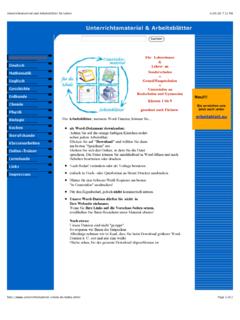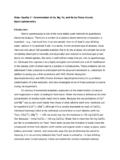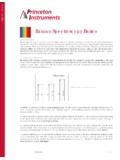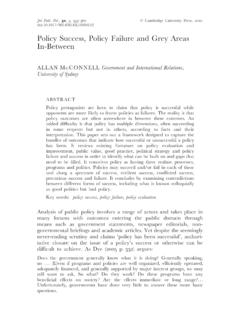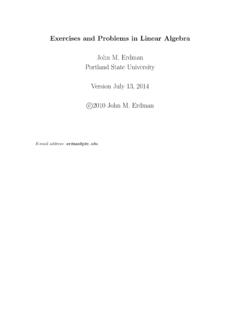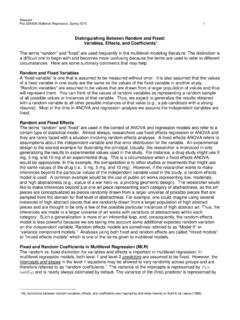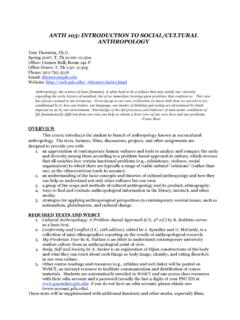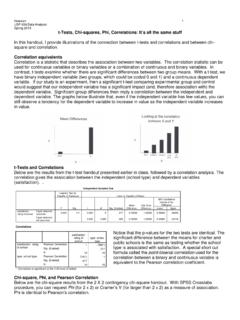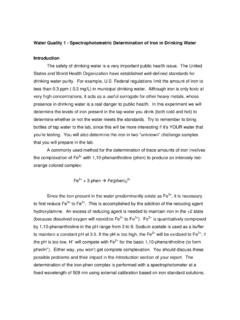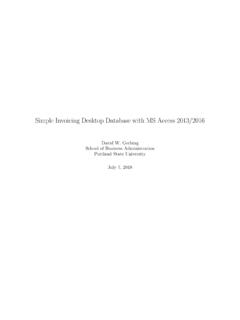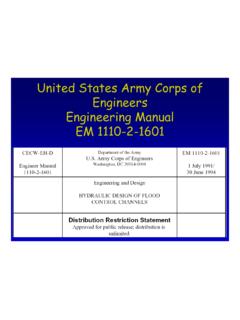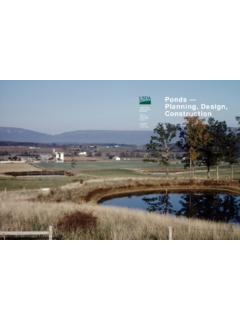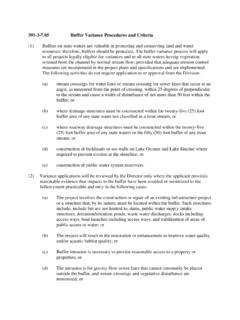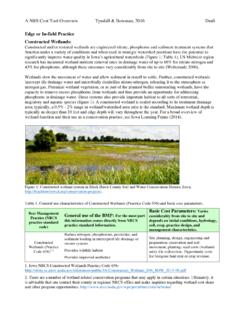Transcription of Theory of Slope Stability - Portland State University
1 Theory of Slope Stability Slumgullion Landslide, Colorado 0m 500 m 1000 m 1500 m 2000 m Prepared for G 483/583 Anatomy of Landslides ( ). by Kenneth M. Cruikshank Portland State University Revision (Spring Term 2002). Based on course notes by Arvid M. Johnson Geo-Tesson Engineering Geology Laboratory Purdue University 2002 Cruikshank and Johnson These notes cannot be reproduced without written permission ii Table of Contents Table of Contents .. i List of Figures .. ii List of Tables .. ii List of Symbols ..iii Some Definitions and Useful Conversion Factors .. iv Typical Material v Summary of useful vi Factor of Safety .. vi Critical Thickness.
2 Vii Unit vii 1. Theory of Slope Stability .. 1. 2. Infinite Slope .. 2. Equilibrium equations .. 2. Dry Soil .. 6. Infinite Slope in standing body of water .. 7. Infinite Slope with seepage parallel to the Slope .. 11. Incorporation of strength controlled by tree roots .. 13. 3. Method of slices .. 16. Introduction .. 16. Fellenius Method .. 19. Modified Bishop Method .. 19. Janbu and Morgenstern-Price methods of Stability analysis .. 21. 4. References .. 26. Alphabetical listing of references .. 26. References by topic .. 33. Appendix A. Mohr's Circle .. 35. Appendix B. Exercises .. 39. Appendix C. Computer Programs .. 47. Appendix D.
3 Janbu (1973) Paper on Slope Stability Computations .. 87. List of Figures Figure 1. Definition diagram for infinite Slope analysis .. 2. Figure 2. Unit element in a slide mass. Note that all the stresses shown are in their positive directions, so that normal stresses are positive if compressive.. 3. Figure 3. Definition diagram for a submerged infinite Slope .. 7. Figure 4. Role of tree roots in reinforcing a soil mass.. 13. Figure 5. Definition diagram for Fellenius and Bishop methods. A simple slip surface is assumed, and the total moments are determined by summing moments for each slice. The factor of safety is defined as the ratio of the sum of the resisting moments divided by the sum of the driving moments.
4 17. Figure 6. Definition diagram for Janbu and Morgenstern-Price methods of Stability .. 21. Figure 7. Definition diagram for (a) forces and (b) stresses. nn is normal to some inclined plane, ns are parallel to the inclined plane.. 35. Figure 8. Definition diagram for the derivation of Mohr's circle.. 37. Figure 9. Mohr's circle showing the parameters in the equations derived above.. 38. Figure 10. Definition diagram for exercise 3.. 41. Figure 11. Definition diagram for exercise 5.. 43. List of Tables Table 1. Summary of root strength data for live sugar maples. From Riesternberg (1981, fig. 12).15. Table 2. Some of the important parameters for each slice in exercise 5.
5 43. ii List of Symbols Symbol Name Use Phi Angle of Internal friction of dry soil Angle of internal friction of saturated soil Residual angle of internal friction of saturated soil r . C Cohesion of saturated soil C. r Residual Cohesion of saturated soil Alpha Ground Slope in Janbu analysis C Cohesion of dry soil Delta Small increment l Length of slip surface in Janbu analysis E Magnitude of thrusting in Janbu analysis F Factor of safety. Defined as resisting forces / driving forces Gamma Unit weight of dry soil s Unit weight of solid particles t total unit weight material a Unit weight of air w Unit weight of water Effective unit weight Eta Height of thrusting above slip surface in Janbu Analysis h Height of water table in Janbu analysis Phi Slope of root with respect to shear zone Theta Tangent to arc in methods of slices analysis Lambda Coefficient in Morgenstern & Price Stability analysis N Normal force N Difference between water pressure and normal force (N U).
6 Theta Slope angle Theta Volume fraction of solids (volume of solids / total volume). Sigma Normal Stress on a slip surface ij Components of the stress tensor S Shear force on slip surface Tau Shear Stress on a slip surface f Fraction of failure strength of soil in Janbu analysis T Shear force t Thickness of slide tc Critical thickness of slide u Pore water pressure U Normal force exerted by pore water pressure on base of slice W Weight of an element x Horizontal distance to edge of slice in Janbu analysis (from toe). y Janbu: Height of slip surface (positive down from datum). y Infinite Slope : Distance ( depth ) measured normal to Slope yt Height of line of thrusting in Janbu analysis z Height of ground surface in Janbu analysis iii Some Definitions and Useful Conversion Factors Stress (ML-1T-2): Force / Area.
7 Common units are: Atmosphere, bar, Pascal, pounds/ft 2, pounds/in2, inHg, dynes/cm2. Force (MLT-2): Mass times acceleration. Common units are: Newton (SI) and dyne (cgs). Pascal. A measure of stress in SI units, defined as one Newton per meter-squared. Newton. A measure of force in SI units. Defined as mass times acceleration. 1 Newton is the force required to accelerate 1 kg of mass at 1 m/s2. Dyne. A measure of force in cgs units. The force required to accelerate 1 gram at 1 cm/s2. Acceleration due to gravity: m/s2, or ft/s2. Density of water (20 C): gm/ml (gm/cm3) or kg/m3. Unit weight of water (20 C): kg m-2 s-2 or kN/m3. Specific gravity: The ratio of the mass of a body to the mass of an equal volume of water at 4 C.
8 Unit conversions can be done using the CONVERT() function in Microsoft Excel, or the unit conversion functions in many calculators. You can also find numerous conversion factor sites on the World Wide Web. A nice book with all forms of conversion factors is: Cook, , 1991. Conversion factors. Oxford Science Publications, Oxford University Press, Oxford. 160 p. From Multiply from by To Atmosphere (atm) Pa Pascal (Pa). 105. atm Pascal (Pa) N m-2 N m-2. 1. Pa Pascal (Pa) dn cm-2. -1 dn cm-2 (dn = dyne). 10. Pa psf (lb ft-2) Pa Pascal (Pa). psf psi (lb in-2) Pa Pascal (Pa). 103. psi pcf (lb ft-3) N m-3 N m-3. pcf feet (ft) m meter (m). ft pound (lb) N Newton (N).
9 Lb pound (lb) kg Kilogram (kg). lb iv Typical Material Values1. Description Unit Weight Friction Cohesion (Saturated / Dry) Angle Type Material Lb / ft3 KN / m3 Lb / ft2 kPa Loose sand, uniform grain size 118/90 19/14 18-34. Dense sand, uniform grain size 130/109 21/17 32-40. Sand Loose sand, mixed grain size 124/99 20/16 34-40. Dense sand, mixed grain size 135/116 21/18 38-46. Gravel, uniform grain size 140/130 22/20 34-37. Gravel Cohesionless Sand and gravel, mixed grain size 120/110 19/17 30-45. Basalt 140/110 22/17 40-50. Blasted/broken rock Chalk 80/62 13/10 30-40. Granite 125/110 20/17 45-50. Limestone 120/100 19/16 35-40. Sandstone 110/80 17/13 35-45.
10 Shale 125/100 20/16 30-35. Soft bentonite 80/30 13/6 7-13 200 400 10 20. Very soft organic clay 90/40 14/6 12-16 200 600 10 30. Soft, slightly organic clay 100/60 16/10 22-27 400 1000 20 50. Clay Soft Glacial clay 110/76 17/12 27-32 600 1500 30 75. Stiff glacial clay 130/105 20/17 30-32 1500 3000 75 150. Cohesive Glacial till, mixed grain size 145/130 23/20 32-35 3000 5000 150 250. Hard igneous rocks 160 to 190 25 to 30 34-45 720000-1150000 35000-55000. Granite, basalt, porphyry Metamorphic rocks 160 to 180 25 to 28 30-40 400000-800000 20000-40000. Rock Quartzite, gneiss, slate Hard sedimentary rocks 150 to 180 23 to 28 35-45 200000-600000 10000-30000.
